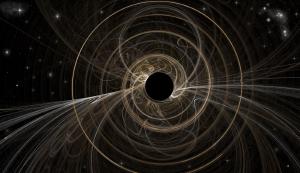Post
Big Bang
Burger Bar
24 September 2013
 The EU’s Communicate Science
The EU’s Communicate ScienceLately there’s been news of a radical new theory proposing that the universe began from a hyper-dimensional black hole. Most of the reports seem to stem from an article posted a while back on the Nature blog, which references the original paper.1 So let’s have a little reality check.
No one is abandoning the big bang model. The original paper hasn’t even been peer reviewed yet and the paper doesn’t present a radical new theory to overturn the big bang. What the paper is actually about is higher-dimensional gravitational theory.
The standard theory of gravity (general relativity) describes our universe as a geometry of three-dimensional space with one dimension of time. This is sometimes called 3 + 1 space, and it gives a very accurate description of the universe we observe. But theorists like to play around with alternative models to see how they differ from regular general relativity. They may look at 2 + 1 space, a kind of flatland with time, or 2 + 2, with two time dimensions. There isn’t necessarily anything “real” about these models, and there certainly isn’t any experimental evidence to support anything other than 3 + 1 gravity, but alternative models are useful because they help us gain a deeper understanding of general relativity. In this particular paper, the authors were exploring 4 + 1 gravity. That is, a five-dimensional universe with 4 spatial dimensions and 1 time.
Back in 2000, another team of authors proposed a model where our regular 3 + 1 gravity could be treated as a brane within a larger 4 + 1 universe. It is similar to the way a 2 + 1 universe could be imagined as a 2-dimensional surface (the brane) within our 3-dimensional space. In the 2000 paper, the authors showed that a particular 4 + 1 universe with a 3 + 1 brane could give rise to the type of gravity we actually see.2
The new paper takes this model one step further. In it, the authors show that 4 + 1 gravity allows for the existence of black holes. So if a 4 + 1 universe had large stars, some of those stars could collapse into a 4-dimensional “hyper black hole”. Like black holes in regular general relativity, these hyper black holes would have a central “singularity” of extremely dense and hot matter/energy. The authors then went on to show that a hyper black hole with the right conditions could not only create a three-dimensional brane, but the new brane would look very similar to the early universe we actually observe.
In other words, if we imagine a five-dimensional 4 + 1 universe, and if such a universe could create stars that collapse into hyper black holes, and if a particular hyper black hole had the right energy, then it might be possible for for such a hyper black hole to produce a 3 + 1 brane-universe with a beginning that looks like a big bang. That’s a lot of ifs.
Just to be clear, this is good theoretical work. The model is interesting, and it shows a curious connection between the universe we observe and higher-dimensional gravity. It could also address some of the issues in cosmology, but it also predicts the universe is flat, which as I mentioned yesterday may not be the case. The authors note this problem, and are careful not to make broad claims. They also outline possible ways that such a model could be tested. This is what good theoreticians do.
But currently there is no experimental evidence to support higher-dimensions, much less hyper black holes. So don’t toss the big bang just yet.
Pourhasan, Razieh, Niayesh Afshordi, and Robert B. Mann. “Out of the white hole: a holographic origin for the Big Bang.” Journal of Cosmology and Astroparticle Physics 2014.04 (2014): 005. ↩︎
Dvali, Gia, Gregory Gabadadze, and Massimo Porrati. “4D gravity on a brane in 5D Minkowski space.” Physics Letters B 485.1-3 (2000): 208-214. ↩︎